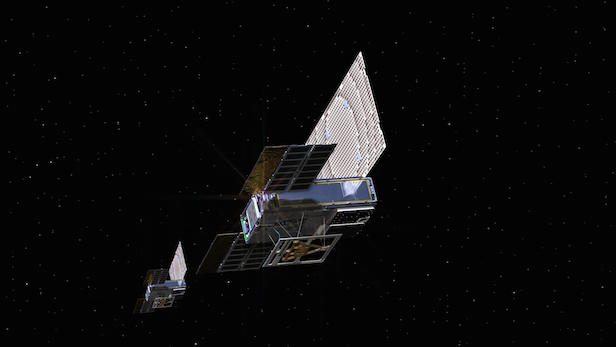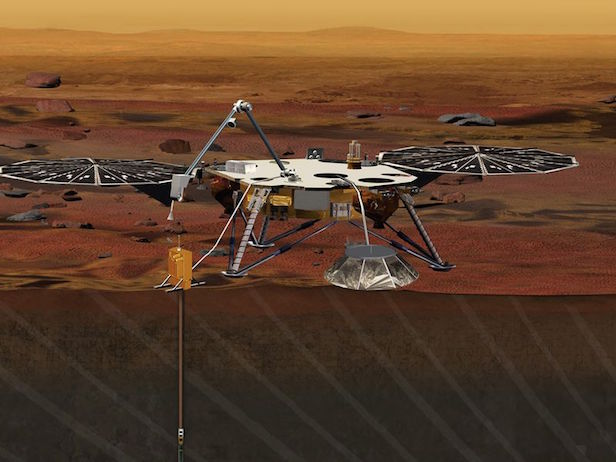‘Polo!’: Mars-bound CubeSats are alive and well
The twin MarCO spacecraft, cruising to the Red Planet along with NASA’s InSight lander, have relayed to Earth that they’re in good health

The twin Mars Cube One spacecraft will cruise through space towards Mars, along with NASA’s InSight mission. Image credit: NASA/JPL-Caltech
NASA scientists rejoice, as the first-ever CubeSats launched into the depths of space are alive and responding. At 12:15 p.m. PST (7:15 p.m. GMT) on 5 May 2018, the first signal was received and then another one followed at 1:58 p.m. PST (8:58 p.m. GMT). This is an excellent sign as engineers can now undergo a series of checks as the two CubeSats enter their cosmic cruise.
Mars Cube One, also known as MarCO, is a pair of briefcase-sized satellites that were launched along with NASA’s InSight mission on the 5 May 2018. InSight, launched from the Vandenberg Air Force Base in California, United States, will be the first Martian probe focussed on understanding the interior of the Red Planet based on its thermal and seismic activity.
The twin MarCO CubeSats is doing something different to InSight, however. Rather than collecting the data about Mars, which is what InSight will be doing, the CubeSats will follow InSight lander and test out miniature spacecraft technologies along the way.
After their launch, both CubeSats were programmed to unfold their solar panels and then report information regarding its health back to Earth. “Both MarCO-A and B say ‘Polo!’ It’s a sign that the little sats are alive and well,” says Andy Klesh, chief engineer for the MarCO mission at NASA’s Jet Propulsion Laboratory in Pasadena, California, which built the twin spacecraft.
The computers that make up each MarCO CubeSat hadn’t been turned on since mid-March. This was when it was tested at California Polytechnic State University, San Luis Obispo, and prepared for launch by Tyvak Nano-Satellite Systems of Irvine, California. What was needed in order to prove successful should not be underestimated for the pair of CubeSats – the batteries had to retain enough charge to ensure the solar panels deploy, stabilise their attitude, turn towards the Sun and finally turn their radio systems on.

If NASA’s InSight lander survives the entry, descent and landing, it will probe the interior of the Red Planet. Image credit: JPL/Caltech
In the next couple of weeks, the MarCO CubeSats will be undergoing tests to assess their performances. Obviously space can be a harsh place, peppered with unfiltered radiation. If they survive this environment, the pair of spacecrafts will fly over Mars during InSight’s entry, descent and landing in November 2018. With special antennas attached, InSight’s intense ‘Seven Minutes of Terror’ will be carefully watched as it does the dangerous descent to the Red Planet.
CubeSats were originally invested so that engineer students can learn the ways in which spacecrafts are built. In recent times, they tend to be utilised by private companies and research institutions as an easy access route to space. CubeSats are just one kind of ‘SmallSat’, which is a much broader range of satellites organised by weight class. CubeSats are normally under 15 kilograms (33 pounds), and can even weigh as little as roughly 2.5 kilograms (five pounds). With their design being distinctively modular, it is easy to relatively generic plug-in parts, as opposed to having to buy specialised parts of the spacecraft.
NASA is very keen on learning about the experimental systems onboard MarCO, including their folding high-gain antennas, attitude controls and propulsion systems. “We’re nervous but excited,” says Joel Krajewski of JPL, MarCO’s project manager. “A lot of work went into designing and testing these components so that they could survive the trip to Mars and relay data during InSight’s landing. But our broader goal is to learn more about how to adapt CubeSat technologies for future deep-space missions.”
On InSight’s arrival at Mars, the data relay back to Earth from this lander is not reliant on MarCO. This is because NASA’s Mars Reconnaissance Orbiter will help with the data relay, along with other Earth-based astronomy telescope. However, if all goes well, MarCO could provide a strong case for future NASA missions to use these ‘bring-your-own black boxes’.
Keep up to date with the latest reviews in All About Space – available every month for just £4.99. Alternatively you can subscribe here for a fraction of the price!




